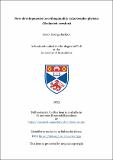New developments in orthogonality catastrophe physics
View/
Date
12/06/2023Author
Supervisor
Grant ID
EP/L015110/1
Keywords
Metadata
Show full item recordAbstract
The Fermi edge singularity, and related Anderson’s orthogonality catastrophe, has been a touchstone of many body quantum physics for over 50 years. There are, however, a number of facets of this phenomenon that have, up until now, been left largely unexplored in the scientific literature. In this thesis we investigate two of these. Firstly we explore how the orthogonality catastrophe spatially spreads through a system, with particular considerations for the implications for quantum information processing implementations. We find that there is a propagating signal carrying the information about the Fermi edge singularity, but at long times the orthogonality catastrophe reasserts itself, posing a significant obstacle to the transmission of quantum information. We also found an “echo” formed by the interference of multiple Fermi edge singularities at different locations. Secondly we consider the effect of band structure on the Fermi edge singularity. Here we make significant progress in analytically understanding the effect of having a finite band bottom and of band curvature on the Fermi edge singularity. In the course of this we clarify some subtle points about the relationship between energy and time in non-relativistic quantum mechanics, which had been glossed over in the previous literature.
Type
Thesis, PhD Doctor of Philosophy
Rights
Embargo Date: 2025-02-20
Embargo Reason: Thesis restricted in accordance with University regulations. Chapter 5 and conclusion restricted until 20th February 2025
Collections
Items in the St Andrews Research Repository are protected by copyright, with all rights reserved, unless otherwise indicated.

